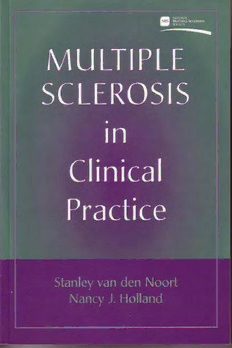Table Of ContentKarp front:Layout 1 7/31/08 2:59 PM Page ii
Multiple Sclerosis
in Clinical Practice
Multiple Sclerosis
in Clinical Practice
Stanley van den Noort, MD, Professor
Department of Neurology
University of California, Irvine
and
Chief Medical Officer
National Multiple Sclerosis Society
and
Nancy J. Holland, EdD
Vice President, Clinical Programs Department
National Multiple Sclerosis Society
DemosMedicalPublishing,Inc.,386ParkAvenueSouth,NewYork,NewYork10016
© 1999 by Demos Medical Publishing, Inc. All rights reserved. This book is pro-
tectedbycopyright.Nopartofitmaybereproduced,storedinaretrievalsystem,
ortransmittedinanyformorbyanymeans,electronic,mechanical,photocopying,
recording,orotherwise,withoutthepriorwrittenpermissionofthepublisher.
LibraryofCongressCataloging-in-PublicationData
Availablefromthepublisheruponrequest
PrintedinCanada
Preface
Almost half a million people suffer from and are diagnosed with multiple
sclerosis(MS)inNorthAmerica,andanunknownnumbersufferfromMS
and are not yet diagnosed. With this prevalence, most primary care clini-
cianswillhaveatleastoneortwopatientswithMSintheirpractice.
Although glucocorticoids have long been the mainstay for the symp-
tomatic treatment of acute episodes of MS, only since 1993 have effective
treatments, such as beta interferon and glatiramer acetate, been available
thatalterthecourseandprogressionofthedisease.
Changes in our ability to diagnose and treat MS have created a para-
dox, shared with other serious, complicated chronic diseases such as
HIV/AIDS.Multiplesclerosishasbecomeatthesametimebothmoreofa
primary care and subspecialty care disease. With more effective treatment
options, the complexity of optimal management requires more and more
subspecialtyexpertise,allthewhileheighteningtheimportanceofthepri-
marycareclinician’sroleinearlydiagnosisandlong-termcomanagement.
Thecollaborationofthepatient,primarycarephysician,MSspecialist,and
other members of the health care team (i.e., nurses, physical and occupa-
tionaltherapists,andothers)becomesevenmoreessentialforoptimalcare.
As a family physician, I learned four important points from Multiple
SclerosisinClinicalPractice:
1. Effective, disease-modifying treatments are now available, making
earlydiagnosisandinitiationoftreatmentimperative.
v
vi PREFACE
2. New diagnostic tools, such as magnetic resonance imaging (MRI),
mayplacetheastuteprimarycarephysicianintheroleofmakinga
diagnosispreviouslymadebyneurologistswhospecializeinMS.
3. These more powerful diagnostic methods may shorten the limbo
beforediagnosis(i.e.,“symptomsseparatedbyspaceandtime”)but
place the acute grief reaction to the diagnosis of a chronic disease
withanuncertainprognosisintheprimarycarephysician’soffice.
4. Patients with MS suffer, of course, from many other common con-
ditions,includingpseudoexacerbations.
The legacy of waiting and waiting—sometimes for years—for the dis-
ease to manifest itself clearly enough for a definitive diagnosis is now his-
torybutmeansnewresponsibilitiesfortheprimarycarephysician,bothin
diagnosisandinlong-termcomanagementwithMSspecialists.
My personal experience may not be typical but my professional expe-
rience with MS probably is. I have one patient in my practice with MS
whose many other problems, including cerebral blindness due to head
traumafromdomesticviolence,dwarfherMSsymptoms.
AnursepractitionercolleaguehasbeendiagnosedwithMSaftersep-
arate episodes of optic neuritis but has had no furtherprogression. Why I
am writing this Foreword comes from more personal experience. My best
friend—Patricia Robertson Amusa-Shonubi—died in 1994 from what her
neurologist,anMSspecialist,describedastheworstcaseofMShehadever
seen.TreatmentcametoolateforPat,andherprimarycarewastragictoo,
butwithwhatyouwillfindinthisbook,youwillbeabletoensurethatoth-
erswillnothavetosufferherfate.
A.H.Strelnick,M.D.
Professor,FamilyMedicine
MontefioreMedicalCenter
AlbertEinsteinCollegeofMedicine
Bronx,NewYork
Foreword
Those of us who work with people who have multiple sclerosis (MS) are
acutelyawareoftheenormouslydifficultconsequencesofthisdisease,for
boththeindividualswithMSandtheirlovedones.Weare,however,fortu-
natetobelivinginatimemorepromisingthaneverbefore—treatmentsto
alter the disease course and relieve many symptoms are now available. It
remains for you, the physician, to bring these therapies to your patients
withMS.Thisiscertainlyawonderfulopportunity,aswellasadifficultchal-
lenge,giventhecomplexitiesandenigmaofthisdifficultdisease.
AsyouprovidehealthcareforpeoplewithMS,theNationalMultiple
SclerosisSocietyisyourpartner,providingprogramstosupportthosewith
MS,theirfamilies,aswellasthephysiciansandalliedhealthprofessionals.
We at the Society thank you for your dedication, knowledge, and skill in
assisting people with MS. Together we will advance the mission of the
NationalMultipleSclerosisSociety,“toendthedevastatingeffectsofMS.”
Gen.MichaelJ.Dugan,USAF,Ret.
President&CEO
NationalMultipleSclerosisSociety
vii

